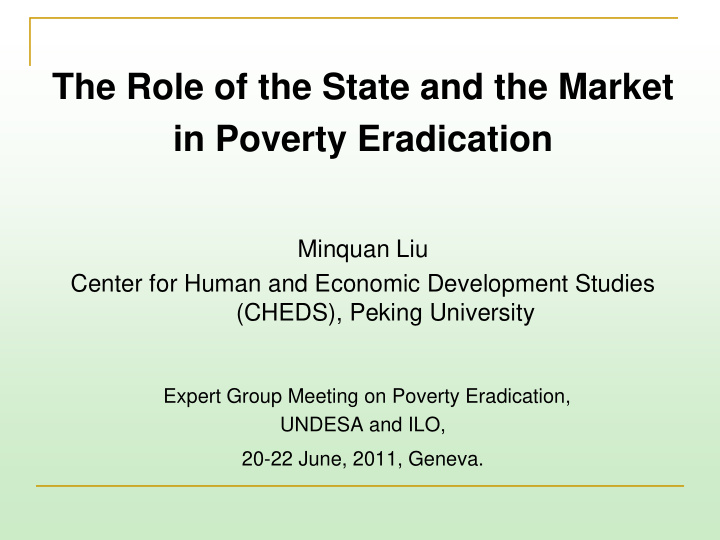



The Role of the State and the Market in Poverty Eradication Minquan Liu Center for Human and Economic Development Studies (CHEDS), Peking University Expert Group Meeting on Poverty Eradication, UNDESA and ILO, 20-22 June, 2011, Geneva.
Contents: The poverty-growth-inequality triangle 1. Development as human capital accumulation 2. The Kuznets Curve 3. A stylized model of skilled and unskilled 4. labor markets Full and successful development 5. The role of the market and the state in 6. development and poverty eradication
1. The Poverty-Growth-Inequality Triangle Bourguignon, 2004
2. Development as Human Capital Accumulation The key to tackling this triangle and achieving development and poverty reduction in the long run lies with human capital accumulation (health and education) A large body of theoretical and empirical literature indicates that human capital, rather than physical capital, accumulation is a much more powerful force driving forward development, especially in an age of rapid innovations and knowledge-intensive industries. Health and education are after all among the basic capabilities that people pursue
3. The Kuznets Curve and Long- run Development The Kuznets Curve in the long run: economic structural changes and urbanization The new literature of endogenous inequalities: financial capital and occupational choice Earnings inequality and segmented labor markets Wage share statistics
4. A Stylized Model The above indicates that if there is anything central to development and poverty reduction in the long run, it is human capital accumulation, especially education. A model of segmented unskilled and skilled labor markets Development as upward integration of these two labor markets through education
Labor Market for the Unskilled W S A M A W AR O A L A
Figure 3: Labor Market for the Skilled W M I S I W IR W AR O I L I
Labor Markets for the Skilled and Unskilled at the Start of Development W W S I M I W I * W IR M A S A W AR O A L M N O I
Development as Skill Formation through Education W W S I M I W I * W IR M A S A * W A W AR O A O I M L, N
5. Full and Successful Development Full development Full development and the Kuznets Curve Successful development Successful development and poverty eradication
6. The Role of the Market and the State in Development and Poverty Eradication Market and state failures The education market: the demand side Do I know future returns from investment Can I borrow against future incomes: the capital market imperfections Private returns and social returns: externalities The education market: the supply side Do I know future demand for places Do I know future demand for quality
6. The Role of the Market and the State in Development and Poverty Eradication Three ways of intervening in the market: Regulation PPP Partially substituting the market The case for public investment in education Supply side: investment in facilities and personnel Demand side: in some sense equity-based entitlements
6. The Role of the Market and the State in Development and Poverty Eradication But also the role of the government in shaping and leading things (or as they say in political science: steering ) The market is, unfortunately, not designed to do this Markets are best at reacting to things (this is after all what the price signal is there for) The government must exercise good vision, commitment and leadership Practical need for planning in matters of education
6. The Role of the Market and the State in Development and Poverty Eradication Some beneficial loops of education: Impact of education on demand for skilled labor Clustering and agglomeration effects Reputation effects Impact of education on fertility The East Asian experience: The NIE China Implications for poverty eradication
Thank You!
Recommend
More recommend